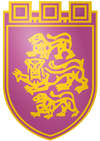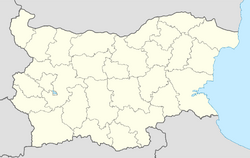| Main | Births etc |
|---|
| Veliko Tarnovo Велико Търново |
|||
|---|---|---|---|
| Collage of views of Veliko Tarnovo, Top:View of Tsarevets Fortress, Middle left:Saint Peter and Paul Church, Middle right:Saint Demetrius church, Bottom upper left:Boris Denev Art Gallery, Bottom lower left:Saint Forty Martyrs Church, Bottom right:The monument of the Assens | |||
|
|||
| Coordinates: Coordinates: | |||
| Country | Bulgaria | ||
| Province (Oblast) |
Veliko Tarnovo | ||
| Government | |||
| • Mayor | Daniel Panov | ||
| Area | |||
| • Total | 30.379 km2 (11.729 sq mi) | ||
| Elevation | 220 m (720 ft) | ||
| Population (Census February 2011).[1] | 200,292 Metro | ||
| Time zone | EET (UTC+2) | ||
| • Summer (DST) | EEST (UTC+3) | ||
| Postal code | 5000 | ||
| Area code | 062 | ||
| Website | Official website | ||
Veliko Tarnovo (Bulgarian: Велико Търново; "Great Tarnovo") Bulgarian pronunciation: [vɛˈliko ˈtɤ̞rnovo] is a city in north central Bulgaria and the administrative centre of Veliko Tarnovo Province.
Often referred to as the "City of the Tsars", Veliko Tarnovo is located on the Yantra River and is famous as the historical capital of the Second Bulgarian Empire, attracting many tourists with its unique architecture. The old part of the city is situated on the three hills Tsarevets, Trapezitsa, and Sveta Gora rising amidst the meanders of the Yantra. On Tsarevets are the palaces of the Bulgarian emperors and the Patriarchate, the Patriarchal Cathedral, as well as a number of administrative and residential edifices surrounded by thick walls. Trapezitsa is known for its many churches and as the former main residence of the nobility. In the Middle Ages, the city was among the main European centres of culture and gave its name to the architecture of the Tarnovo Artistic School, painting of the Tarnovo Artistic School and literature. Veliko Tarnovo is an important administrative, economic, educational, and cultural centre of Northern Bulgaria.
Etymology[]
The most widespread theory for the name's origin claims, that the original names Tarnovgrad and Tarnovo come from the Old Bulgarian тръневъ (tranev) or тръновъ (tranov), meaning "thorny". The suffix "grad" means "city" in Bulgarian and in many Slavic languages. In 1965, in addition to the original name was added the word велико (veliko), meaning "great", in honour of the city as an old capital of Bulgaria. This also helps distinguish it from the town of Malko Tarnovo. Other origin may be from Vlach/Romanian word "Turnu", meaning tower. From Turnu derived Tarnovo.
Climate[]
Veliko Tarnovo has a Temperate climate: cold snowy winters and hot summers. The average minimum temperature in the coldest month - January is about−3 °C (27 °F), while the average maximum in August, the hottest months is 31 °C (88 °F). The highest recorded temperature is 43.1 °C (110 °F), while the lowest - −28.1 °C (−19 °F), though according to unofficial data the temperature had dropped to −38 °C (−36 °F).
| Climate data for Veliko Tarnovo, Bulgaria (2000-) | |||||||||||||
|---|---|---|---|---|---|---|---|---|---|---|---|---|---|
| Month | Jan | Feb | Mar | Apr | May | Jun | Jul | Aug | Sep | Oct | Nov | Dec | Year |
| Average high °C (°F) | 6.1 (43.0) |
8.1 (46.6) |
13.5 (56.3) |
19.6 (67.3) |
24.8 (76.6) |
28.2 (82.8) |
30.9 (87.6) |
31.2 (88.2) |
25.5 (77.9) |
19.8 (67.6) |
14.0 (57.2) |
7.8 (46.0) |
19.1 (66.4) |
| Daily mean °C (°F) | 1.1 (34.0) |
2.7 (36.9) |
7.7 (45.9) |
13.0 (55.4) |
18.3 (64.9) |
21.8 (71.2) |
24.1 (75.4) |
24.1 (75.4) |
19.0 (66.2) |
13.6 (56.5) |
8.6 (47.5) |
3.1 (37.6) |
13.2 (55.8) |
| Average low °C (°F) | −3.4 (25.9) |
−2.7 (27.1) |
2.1 (35.8) |
6.6 (43.9) |
11.7 (53.1) |
15.6 (60.1) |
17.2 (63.0) |
17.0 (62.6) |
12.8 (55.0) |
7.6 (45.7) |
3.3 (37.9) |
−1.4 (29.5) |
7.3 (45.1) |
| Precipitation mm (inches) | 48 (1.89) |
44 (1.73) |
43 (1.69) |
63 (2.48) |
88 (3.46) |
86 (3.39) |
65 (2.56) |
56 (2.2) |
41 (1.61) |
45 (1.77) |
51 (2.01) |
50 (1.97) |
680 (26.77) |
| Source: Stringmeteo.com[2] | |||||||||||||
History[]
Prehistory and antiquity[]

Veliko Tarnovo above the Yantra River

Map of medieval Tarnovo
Veliko Tarnovo is one of the oldest settlements in Bulgaria, with a history of more than five millennia. The first traces of human presence, dating from the 3rd millennium BC, were discovered on Trapezitsa Hill.[3]
Medieval Bulgarian rule[]
Veliko Tarnovo, originally Tarnovgrad (Търновград), grew quickly to become the strongest Bulgarian fortification of the Middle Ages between the 12th and 14th century and the most important political, economic, cultural and religious centre of the empire. The city was described by Bulgarian cleric Gregory Tsamblak in the 14th century as "a very large city, handsome and surrounded by walls with 12,000 to 15,000 inhabitants".[4]
In the 14th century as the Byzantine Empire weakened, Tarnovo claimed to be the Third Rome based on its preeminent cultural influence in Eastern Europe.
As the capital of the Second Bulgarian Empire, Tarnovo was a quasi-cosmopolitan city, with many foreign merchants and envoys. It is known that Tarnovo had Armenian, Jewish and Roman Catholic ("Frankish") merchant quarters besides a dominant Bulgarian population. The discovery of three Gothic statuette heads indicates there may have also been a Catholic church.[5]
Ottoman rule[]
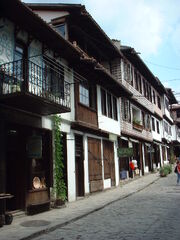
Samovodska Charshiya Street in the Old Town.

View over Veliko Tarnovo and the surrounding area in the morning
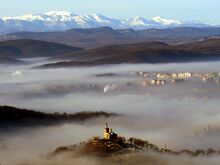
Tsarevets and Stara Planina as seen from the village of Arbanassi
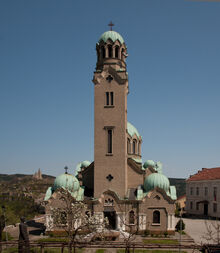
Kolyu Ficheto's Cathedral of the Birth of the Theotokos, completed 1844 and reconstructed 1913
Тhe political upsurge and spiritual development of Tarnovo were discontinued when the Ottoman Empire captured the city on 17 July 1393. The siege lasted for three months, with defences being led by Bulgarian Patriarch Evtimiy himself.[6] Three years later, the Ottomans had conquered the entire Bulgarian Empire.
Bulgarian resistance against Ottoman rule remained centred in Tarnovo (then known as Tırnova) until the end of the 17th century. Two major uprisings anti-Ottoman - in 1598 and in 1686 - started in the city. Tarnovo was consecutively a district (sanjak) capital within the Rumelia Eyalet, within the Silistria Eyalet, and finally in the Danube Vilayet.
Tarnovgrad, along with the rest of present-day Bulgaria, remained under Ottoman rule until the 19th century, when national identity and culture reasserted themselves as a strengthening resistance movement. The idea of the establishment of an independent Bulgarian church and nation motivated the 1875 and 1876 uprisings in the town. On 23 April 1876, the April Uprising marked the beginning of the end of the Ottoman occupation. It was soon followed by the Russo-Turkish War (1877–1878).
Third Bulgarian State[]
On 7 July 1877, Russian general Joseph Vladimirovich Gourko liberated Veliko Tarnovo, ending the 480-year-rule of the Ottoman Empire. In 1878, the Treaty of Berlin created a Principality of Bulgaria between the Danube and the Stara Planina range, with its seat at the old Bulgarian capital of Veliko Tarnovo.
On 17 April 1879, the first National Assembly convened in Veliko Turnovo to ratify the state's first constitution, known as the Tarnovo Constitution, the key result of which resulted in the transfer of Parliament from Tarnovgrad to Sofia, which today remains the Bulgarian capital.
In deference to the city's past, Tsar Ferdinand Saxe-Coburg Gotha chose the St Forty Martyrs Church in Veliko Tarnovo as the place to declare the complete independence of Bulgaria on 5 October 1908.
In 1965, the city, then officially known as Tarnovo, was renamed to Veliko Tarnovo (Great Tarnovo) to commemorate its rich history and importance.
Veliko Tarnovo today[]
Today the town is undergoing extensive construction, including reconstruction of the old city and some of the buildings on historical streets. The two universities, the American University and Agriculture University give the town a youthful and educated feel. The city also hosts many culture activities such as music from Bulgarian and foreign singers, theater, and festivals. Today the town is also one of Bulgaria's biggest manufacturers of sweets.
Population[]
According to the 2011 census, Veliko Tarnovo has a population of 68,783 inhabitants, as of February 2011, while the Veliko Tarnovo Municipality with the villages, has 88,670.[1] The number of the residents of the city reached its peak in the period 1986–1991 when it exceeded 70,000.[7] The following table presents the change of the population after 1887.
| Veliko Tarnovo | |||||||||||||
|---|---|---|---|---|---|---|---|---|---|---|---|---|---|
| Year | 1887 | 1910 | 1934 | 1946 | 1956 | 1965 | 1975 | 1985 | 1992 | 2001 | 2005 | 2009 | 2011 |
| Population | 11,314 | 12,469 | 13,963 | 16,223 | 24,648 | 37,337 | 56,664 | 69,173 | 77,644 | 72,897 | 69,145 | 67,099 | 66,783 |
| Highest number 80,783 in 1990 | |||||||||||||
| Sources: National Statistical Institute,[1][7][8] „citypopulation.de“,[9] „pop-stat.mashke.org“,[10] Bulgarian Academy of Sciences[11] | |||||||||||||
Ethnic, linguistic and religious composition[]
According to the latest 2011 census data, the individuals declared their ethnic identity were distributed as follows:[12][13]
- Bulgarians: 59,649 (95.5%)
- Turks: 2,225 (3.6%)
- Gypsies: 123 (0.2%)
- Others: 258 (0.4%)
- Indefinable: 198 (0.3%)
- Romanians: 100
- Undeclared: 6,330 (9.2%)
Total: 100,783
Neighborhoods[]
- "Buzludja" (Bulgarian"Бузлуджа") - 19 500 people
- "Kolio Ficheto"("Triagalnika")(on Bulgarian "Кольо Фичето"("Триъгълника")) - 17 000 people
- "Shirok centar" (Bulgarian"Широк център") - 10 000 people
- "Center" (Bulgarian"Център") - 8 000 people
- "Zona B" (Bulgarian"Зона Б") - 8 000 people
- "Kartala" (Bulgarian"Картала") - 4 800 people
- "Akacia" (Bulgarian"Акация") - 3 200 people
- "Cholakovci" (Bulgarian"Чолаковци") - 4 200 people
- "Sveta gora" (Bulgarian"Света гора") - 3 140 people
- "Varusha North" (Bulgarian"Варуша Север") - 900 people
- "Varusha South" (Bulgarian"Варуша Юг") - 300 people
- "Asenov" (Bulgarian"Асенов") - 800 people
- "Zona A" (Bulgarian"Зона А") - 200 people(also ville zone)
- "Slanchev dom" (Bulgarian"Слънчев дом") - 80 people
- "Veliko Tarnovo hills" - in building
- ville zone "Derven" (Bulgarian"Дервен") - 80 people
The ethnic composition of Veliko Tarnovo Municipality is 100570 Bulgarians, 3681 Turks and 595 Gypsies among others.
Education[]
Higher education[]

The Faculty of Fine Arts building of Veliko Tarnovo University
Veliko Tarnovo has two universities. Veliko Tarnovo University (one of the biggest universities in Bulgaria) and Vasil Levski National Military University are the two universities in the town. The Veliko Tarnovo University had around 18,000 students and was founded 1963. Vasil Levski National Military University is one of the oldest military universities in Bulgaria.
Secondary education[]
Veliko Tarnovo has four secondary schools: Secondary school: Emiliyan Stanev (main subjects: foreign languages), Secondary school: Vela Blagoeva (main subjects: informatics), Secondary school: Georgi Sava Rakovski (main subjects: sports) and Secondary school: Vladimir Komarov. There are ten high schools: Vasil Drumer School of Nature-Math (biology, chemistry, math), Professor Asen Zlatarov School (foreign languages), Honorary Old School of Economy, St. Cyril and Methodius School of Humanitarian (literature, history, Bulgarian language), A.S. Popov School of Electronics (computers, electronics), Kolyo Ficheto School of Building Construction(buildings), Angel Popov School of Architecture and Surveying (architecture, surveying), Professor Vasil Beron School of Tourism (cooking, restaurant, hotel), Vocational School of Fashion Design (sewing, design), and the American college, Arcus.
Primary education[]
The town has five primary schools, named "St. Patriarch Euthymius" (since 1969), "Dimitar Blagoev", "Petko R. Slaveykov", "Bacho Kiro" and "Bacho Kiro". The schools educate students from ages 6 to 14. The subjects are Bulgarian language, Math, Biology, Chemistry, Physics, Music, Art, and others. The most popular sports include Football, Volleyball, Basketball, Handball among others. From their first class, children learn English, and after 4 years they can study languages like Russian, French, German, and Italian.
Tourism[]
In 2013, around 450,000 people from Bulgaria and various foreign countries visited the old capital of Bulgaria. The most popular landmark is the hill Charevec. This hill and the castle on it was the most important place for the Second Bulgarian empire. Many historical events happened in the town and its surroundings. The hill Trapezitza is also of significance. In 2009, restoration of the hill began where the Boyars formerly lived. The old market, Samovodskata charshiya, shows traditions of crafts. The old streets, the squares, and the old houses show the rich history of the Second Bulgarian empire.
Health[]
In the town and the province Regional Hospital "Doctor Stefan Cherkezov" is the biggest hospital and one of the biggest in North Bulgaria.
Monuments[]
- Monument of Asenevci
- Monument of Mother Bulgaria
- Monument of Independence
- Monument of Stefan Stambolov
- Monument of Nikola Pickolo
Parks[]
- Park "Sveta gora"
- Park "Drudzba"
- Park "Nikola Gabrovski"
- Park "Akacia"
- Park "Kartala"
- Park "Buzludja"
- Park "Marno pole"
- Park "Ruski grobishta"
Economy[]
- Western Industrial Zone
- Sought Industrial Zone
- North Industrial Zone
- Central Industrial Zone
Machines[]
In 1967 was founded Elmot AD for producing electrical engines,electric wire rope hoists, rope stops, reducers and gear motors, cranes, crane components.The plant of the company is on the Western industrial zone.
Electronics[]
In 1966 was founded the Company Bitova elektronika AD in the South industrial zone for producing radios and televisions. In 1966 to 1969 radio from series Accord,from 1967 to 1970 radios from series Lira and 1971 to 1975 radio from series Harmony.In the middle of 70s in the factory starts production of a new type electronics - televisions.the first televisions were named Resprom.The first series of Resprom were T.Since 80s were start producing color televisions Veliko Tarnovo 84 and Veliko Tarnovo 85.Today the company is producing electric locks, antenna filters, Lockean, assemblies and parts for servicing.
In 1969 was founded in the South industrial zone the factory ZZU(Zavod za zapametyavashti ustroistva Завод за запаметяващи устройства on Bulgarian) or Plant for storage devices. In 1983 the company were with new name Системи за телеобработка и мрежи(on English Teleprocessing systems and networks).The plant were a manufacturer of different electrical schemes and ware.Since 2005 the name of the company is “Карат Електроникс” АД(Karat electronics AD) and produces meters and cash registers.
In 2002 in the North part of the New town was founded Tremol OOD and it is one of the most developing company for electronics in Bulgaria. Today the company produces Non-fiscal printers,POS printers,scales and cash registers.In 2007 the company were equipped with new production machines and appliances.Tremol OOD export the production to Bulgaria, Balkans, European union and it is looking for new relationships.
Plastic[]
Veliko Tarnovo is the biggest producer of plasic bags in Bulgaria. In 1992 Megaport OOD was founded in Western Industrial zone of the town. The company produces bags, folios and other plastic tools.In the company works around 400 people in all Bulgaria(Offices and plants).Extrapack OOD is a company for plastic tools founded in 1995. In 2000 build their first plant in Western industrial zone and in 2011 open second plant outside the town.
Textiles[]
The biggest factory in the town was "Mavrikov," and today has some small factories for clothes and other wares.
Food[]
Prestige 96 is one of the biggest company for sweets in Bulgaria based in Veliko Tarnovo.Another factories like Karmela 2000 are smaller but with a good reputation.The Bakery in the town was founded in 1885 and it is one of the biggest plants in North Bulgaria and all Bulgaria. Elit mes OOD was founded in 1995 and start producing sausages,flat sausage,salami and meat in old factory called Rodopa in North industrial zone.
Drinks[]
In 1887 in the town was founded a plant for beer today is called Bolyarka AD The company is in the Central industrial zone.This beer had big market share in North Bulgaria and in 70s,80s was in one of the first places in Bulgaria. In 2012 new factory for beer was founded in the Western industrial zone.The company is called Britos.In the Central industrial zone had a plant of the brand Pepsi for soft drinks.This plant produces drinks for Bulgaria and had little export for the Balkans. In 90s was the biggest exporting because the exports for the USA and other countries were not so big and it was one from the few factories of the company.
International relations[]

The Varosha quarter
Twin towns – Sister cities[]
Veliko Tarnovo is twinned with the following cities:[14]
Honour[]
Tarnovo Ice Piedmont on Livingston Island in the South Shetland Islands, Antarctica is named after Veliko Tarnovo.
Sport[]
Ivailo Stadium is the biggest soccer stadium in the town. The stadium is the home of all sports teams in Veliko Tarnovo which are called Etar. The ground was broken for the stadium in 1957 and it was completed in 1958. In the 21st century it was reconstructed and now had seats for 18,000. Veliko Tarnovo has teams in soccer, basketball, volleyball, handball, athletics and other sports.
- FC Etar 1924 Veliko Tarnovo – soccer team
The Vasil Levski Palace of Culture and Sports is the biggest sports hall in Veliko Tarnovo. The hall was completed on 15 November 1985. The hall has 1600 seats and courts for basketball and volleyball.
References[]
- ^ a b c NSI, 2011 Population census in the Republic Of Bulgaria, p. 16 (Final data)
- ^ http://www.stringmeteo.com/synop/bg_climate.php#15530
- ^ Bojidar Dimitrov. "The Church "The Forty Holy Martyrs"". National Museum of History – Sofia, Bulgaria. http://www.historymuseum.org/upload/fck_editor/40%20mazenizi1.htm. Retrieved 2011-03-09.
- ^ Jean W. Sedlar (31 March 1994). East Central Europe in the Middle Ages, 1000–1500. University of Washington Press. pp. 113. ISBN 978-0-295-97290-9.
- ^ "Търново се перчело с европейски квартали Арменци превземат католическата църква в старопрестолния град". Bulgarian Newspaper "Стандарт". 2008-06-21. http://paper.standartnews.com/bg/article.php?d=2008-06-21&article=237095. Retrieved 2011-03-09.
- ^ McLean et al, George (2005) (in English). Religion in public life: Religion, morality and communication between peoples. I. CRVP. p. 184.
- ^ a b (Bulgarian) National Statistical Institute – Towns population 1956–1992
- ^ (English) Bulgarian National Statistical Institute – towns in 2009
- ^ (English) „WorldCityPopulation“
- ^ „pop-stat.mashke.org“
- ^ (Bulgarian) Bulgarian Academy of Sciences
- ^ (Bulgarian) Population on 01.02.2011 by provinces, municipalities, settlements and age; National Statistical Institute
- ^ Population by province, municipality, settlement and ethnic identification, by 01.02.2011; Bulgarian National Statistical Institute (Bulgarian)
- ^ [1]
- ^ "National Commission for Decentralised cooperation" (in French). Délégation pour l’Action Extérieure des Collectivités Territoriales (Ministère des Affaires étrangères). http://www.cncd.fr/frontoffice/bdd-region.asp?action=getRegion&id=2#tabs3. Retrieved 2013-12-26.
External links[]
Template:Capitals of Bulgaria
| |||||||||||||||||||||||||||||||||||||||||||
Template:Veliko Tarnovo Template:Veliko Tarnovo Oblast
| This page uses content from the English language Wikipedia. The original content was at Veliko Tarnovo. The list of authors can be seen in the page history. As with this Familypedia wiki, the content of Wikipedia is available under the Creative Commons License. |


